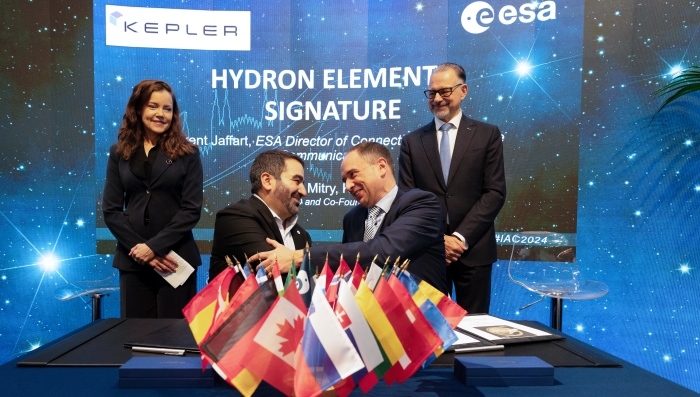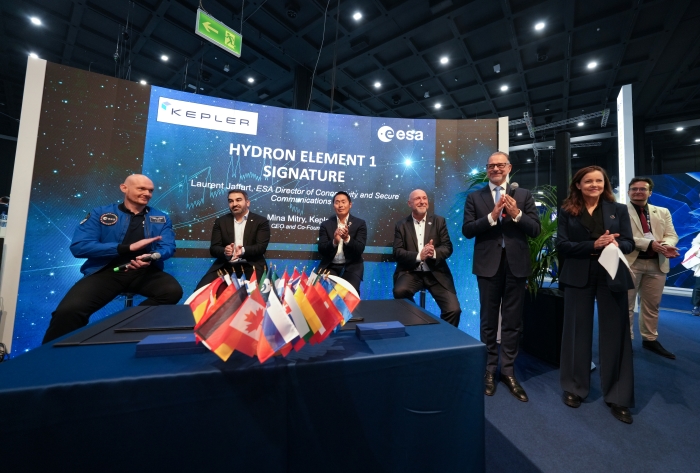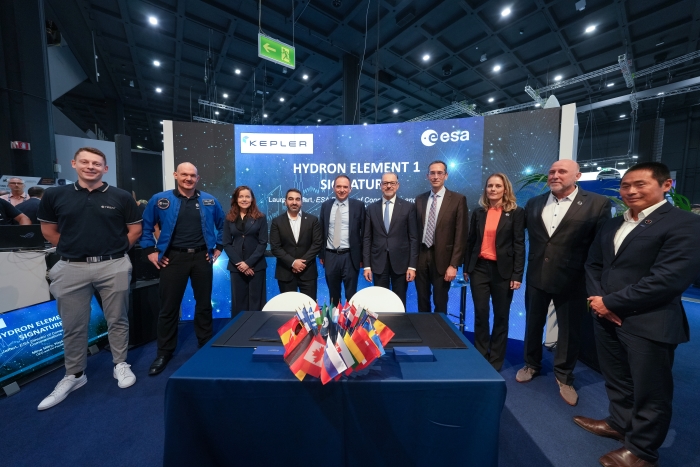ESA-Kepler Communications partnership signals start of development phase of HydRON’s LEO ring layer

The role of optical communication in space missions continues to gain importance with ESA’s multi-orbit High-throughput Optical Network in Space (HydRON) project, which aims to demonstrate European and Canadian technological maturity as well as stimulate industry in maintaining technological leadership during the emerging developments of satellite communication.
As part of ESA’s Optical and Quantum Communications - ScyLight programme, ESA Director of Connectivity and Secure Communications, Laurent Jaffart opened the event with some words before signing the contract for Element #1 of the HydRON project. Following this, a panel session took place between ESA Head of Optical and Quantum Programme – ScyLight, Harald Hauschildt , ESA Astronaut Alexander Gerst, Canadian Space Agency (CSA) Director General for Space Science and Technology, Tuan Huynh, and Kepler Communications Inc. CEO and Co-Founder, Mina Mitry. The signature was closed with remarks from ESA Director General Josef Aschbacher and CSA President, Lisa Campbell, taking place on 16 October 2024 at the International Astronautical Congress, Milan, Italy.

Element #1, which is the first of three elements for the project, will see a Kepler Communications-led consortium develop the Low Earth Orbit (LEO) ring layer of the HydRON system. The ring layer will support communications between the space and ground user. The contract signature signals the start of two phases within Element #1, the development of the space and ground segments for the LEO ring layer.
Additionally, Element #2 will develop a high-throughput optical LEO Multi-Orbit Extension Layer. Meanwhile, Element #3 will focus on developing a demonstration/service user segment, with contributions from commercial and institutional partners interested in working with HydRON or exploiting its commercial services.
Optical and quantum communications are forming the future of communication systems. This first element of HydRON forms the basis of the wider objectives of the vision, with a focus on supporting optical communication which is able to communicate back and forth between orbits.
This capability provides the context for the integration of terrestrial and non-terrestrial networks, expanding optical capabilities on Earth, as well as preparing for networking and communication capabilities beyond Earth. Through the base layers made now, there is potential for HydRON to support lunar and Solar System missions through an optical deep space network extension of the project.
As part of ESA’s coordination, all elements as part of HydRON will be inter-operable with each other, with the prime responsible for the operating each element (in the case of Element #1, Kepler Communications). All the elements form the HydRON Demonstration System (DS), this will aim to demonstrate and validate necessary and key systems required for the HydRON project. The DS works to ensure the technological capabilities and goals are achieved, then allow for industry to upscale technologies to provide service capabilities for a variety of users, such as institutional partners.

HydRON requires the orchestration of various players and capabilities, with operators, satellite primes, equipment suppliers and potential space and ground users all in consultation to ensure the success of the project. For example, ESA works closely with project partner, the German Aerospace Centre (DLR), who offer longstanding support for HydRON's technological development - in particular, the system demonstrator, ground and space segments. ESA also coordinates to ensure the needs of stakeholders, with the project playing a pivotal role in driving Europe to regain leadership within the satellite communication sector. The partnerships allow for future-facing and innovative risk sharing.
"ESA is proud of the HydRON project, which exemplifies the power of European and Canadian collaboration in advancing space technology. With its laser satellite network for lightning-fast internet communications, HydRON has the potential to transform how we connect globally, bridging digital divides and enabling secure communications on Earth and beyond," says ESA Director General Josef Aschbacher.
“The signing of the Element #1 contract marks a significant milestone in advancing optical and quantum communications in space,” said Laurent Jaffart, ESA’s Director of Connectivity and Secure Communications. “ESA is proud to be supporting future-facing and innovative risk sharing, driving space-based communications and potential future lunar and Solar System missions.”
“For 45 years now, Canada’s collaboration with ESA has resulted in opportunities to participate in European space program projects that would otherwise be out of reach. For Canadian companies, having this unique access to the European space market means commercialisation prospects and concrete sales, job creation and knowledge-sharing, and international partnerships opportunities. We look forward to continuing this partnership to strengthen the strong synergies between our industrial, academic and government sectors as we advance space science and technology together,” said Lisa Campbell, President of the Canadian Space Agency.
“Kepler is proud to lead the HydRON Element#1 contract, collaborating with TESAT and Airbus Defence and Space to deliver a state-of-the-art optical constellation that will enable the development of terabit-per-second data relay in space,” said Mina Mitry, Chief Executive Officer and Co-Founder of Kepler. “This programme is aligned with Kepler’s core mission to extend Internet connectivity to space and will improve secure access to space-generated data for all ESA Member States.”
Part of ESA’s wider Advanced Research in Telecommunications Systems (ARTES) programme, the HydRON project sits under the Optical and Quantum Communications – ScyLight programme. It supports the research, development and utilisation of optical and quantum technologies, through supporting industry in its manufacturing capabilities. The programme helps prepare European and Canadian industry stakeholders to seize market-related opportunities.


